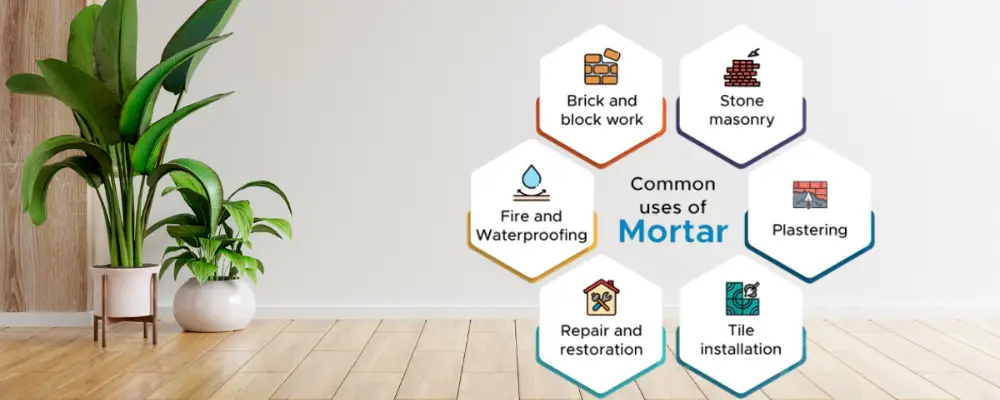In construction industries, mortars play a significant role as a binding material. It is made by mixing sand, cement, water, and sometimes lime. It is formed as a paste that will harden when dried and used to hold the components of the building together. Mortar can give stability to brickwork, stonework, and also concrete structures.
This blog will provide you with details regarding the importance of mortars, its functions, and applications in the construction industry.
Importance of Mortar in Construction
Due to the ability to give strong adhesive bonds between building elements, mortars are commonly used in construction. If mortar is not used, then structures like brick walls, stone buildings, and others can lack integrity. Some of the important reasons for the need for mortar are,
- Structural stability
- Even the distribution of loads
- Weather resistance
- Aesthetic finishing
- Durability and longevity
Functions of Mortar
- Bonding Materials Together
- Creating a Strong Foundation
- Filling Gaps and Voids
- Sealing and Protecting
- Distributing Loads
- Cushioning and Flexibility
- Improving Insulation
- Enhancing Aesthetic Appeal
- Supporting Workability
- Facilitating Repairs
Applications of Mortar in Construction
Mortar can be used in various applications of construction. Some of the key applications are,
Plastering with Mortar
For the creation of smooth and even surfaces, mortar layers are applied to the walls and ceilings, and this process is called plastering. This process helps in improving the visual appearance of the interior and also prepares the surfaces for painting. Plaster mortars normally have a mixture of lime or cement with sand, and water. It provides a finish that is durable as well as aesthetically pleasing.
Mortar for Filling
For filling the gaps and cracks in built forms, mortar is commonly used. For example, in the space between the bricks where any minor cracks in the wall have developed, mortar can help in sealing it tightly and preventing air and moisture penetration. This helps in the maintenance of structural integrity by preventing environmental damage to the buildings.
Binding Materials with Mortar
Mortar acts like glue and attaches different building blocks to one another. It ensures that all materials are in place and forms a solid and cohesive structure that will not fall apart easily. It has the ability to distribute the weight across the structure and helps in preventing cracks or failures. Lime mortars can be used in the historical restoration process because of their breathability and flexibility. Cement mortar can be used in modern construction because of its durability and strength.
Waterproofing with Mortar
Some mortars have special formulations that can resist water. This type of mortar is mainly used for waterproofing basements, pools, and other structures that are exposed to water. This helps in the protection of the building structure from water damage that can cause moulding, deterioration, or structural weakening.
Mortar in Structural Repairs
Mortars can be used in making structural repairs in brick walls, for cracks in the foundation, or for filling the gaps in the concrete structure. The mortar can be used for restoration and maintenance of buildings and integrity. There are some specialised repair mortars that can be used for patching the cracks and damaged areas. These are mainly used for correcting the existing concrete surfaces and restoring their strength and functionality.
Mortar for Fire Resistance
Mortars can also be made for providing fire-resistant properties. These are mainly used in the construction of chimneys, fireplaces, and other structures that experience very high temperatures and are mainly designed for withstanding high heat without loss in the structural integrity of the building. Mortar also helps in preventing fire from spreading to other parts of the building.
Adhesive Application
Mortars can be used as adhesives for tiles, stone veneers, and other decorative materials. These mortars can be called thin-set mortars that have a special ability for providing excellent bonding strength and flexibility. This makes them suitable for the adherence of tiles to floors,walls, ceilings and other similar building surfaces.
Mortar for Decorative Elements
Mortar can be used for the preparation or creation of decorative elements such as cornices, mouldings and small projections on exterior or interior surfaces. It is easy to apply and flexible, allowing quick creation of intricate patterns and forms. It is also resistant to adverse weather conditions and durable, making it a popular material for architectural decoration.
Conclusion
Mortar is an important material in construction that has various uses, starting from binding and plastering to appearance improvement. By understanding its applications, the correct and most appropriate type can be selected for ensuring stability and durability of built forms.
FAQs
Mortar mixes are gauged based on the ingredient ratio. Some ingredients are cement, sand, water, and sometimes lime. The commonly used ratios are 1:3 cement to sand for general construction purposes. For other applications like plastering, the ratio will be 1:4 for cement to sand.
After the mortar is mixed, it can be kept for about 90 minutes to 2 hours. After that, it will start to harden. It is important to use it within this time as the hydration process will start immediately. After two hours, the mortar loses its ability to bond and becomes ineffective. If the work is done in hot weather, then drying may take place even faster. The best practice would be mixing it in small batches as needed.
Cement is a component that acts as a glue that will bind water and sand to create mortar. A mortar is a product that is produced from mixing the cement with water and sand.
Yes, mortar is normally thicker compared to cement when it is mixed. Mortar has a high ratio of sand and cement that can provide it with a paste-like consistency. At the same time, cement is normally mixed with less sand and more water, as required for the production of concrete or for other applications.

